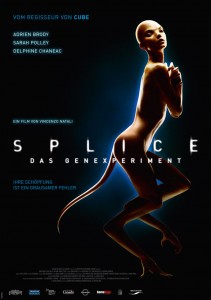 Today various news outlets are reporting that a scientist and his team have created the first synthetic life form, in this instance the genome of a bacterium. Coincidentally, advertisements have begun for Splice, a film that adds to the canon of horror and science fiction dealing with genetic manipulation. The film’s website includes the following synopsis:
Today various news outlets are reporting that a scientist and his team have created the first synthetic life form, in this instance the genome of a bacterium. Coincidentally, advertisements have begun for Splice, a film that adds to the canon of horror and science fiction dealing with genetic manipulation. The film’s website includes the following synopsis:
Superstar genetic engineers Clive (Adrien Brody) and Elsa (Sarah Polley)
specialize in splicing DNA from different animals to create incredible new hybrids. Now they want to use human DNA in a hybrid that could revolutionize science and medicine. But when the pharmaceutical company that funds their research forbids it, Clive and Elsa secretly take their boldest experimentation underground—risking their careers by pushing the boundaries of science to serve their own curiosity and ambition. The result is Dren, an amazing, strangely beautiful creature of uncommon intelligence and an array of unexpected physical developments. At first, Dren exceeds their wildest dreams. But as she grows and learns at an accelerated rate, her existence threatens to become their worst nightmare.
Newsarama.com makes several interesting observations about the film. The first relates to its classification as a horror/science fiction hybrid. While I appreciate this attempt at putting this film into an appropriate category, nevertheless, several critics and scholars have noted that strict definitional boundaries between genres are difficult if not impossible to maintain. At any rate, Splice attempts to bring together elements found in both horror and science fiction regardless of the overlap or fusion.
Another interesting aspect of the film was the inspiration, in part, from a picture of the Vacanti Mouse, disturbing genetically engineered rodent which scientists used to attach and grow human ear tissue. The image of this mouse, and the genetic issues surrounding it, provided an important impetus for Splice.
Yet another interesting facet of the film comes from the names of the main characters, Clive and Elsa, taken from Colin Clive and Elsa Manchester, the actors in The Bride of Frankenstein. Of course, the Frankenstein novel and films have been extremely important mythically and symbolically in popular culture as it relates to genetic engineering. See Susan Tyler Hitchcock‘s Frankenstein: A Cultural History (W.W. Norton, 2007) for an overview and exploration of this.
The production notes for the film also reference an importance facet of this film related to mythic hybrids:
While focusing on the cutting edge of bio-engineering,..“Splice” also exposes a primal fantasy lying deep in the human psyche. “The notion of bonding with something not entirely human goes back to ancient myth. It has always existed and I was fascinated by the idea that those mythic concepts—mermaids, centaurs, chimeras, human hybrids that have tantalized people’s imaginations for thousands of years—could exist in the real world through new science. While ‘Splice’ is very much about the vanguard of genetic research, it’s also about things that have been with us since the beginning of time.”
Finally, Newsarama.com considers Splice a piece of “smart sci-fi,” in the same league as 9, District 9, and Moon. I hope this is the case. The film was well received at Sundance Film Festival, and Guillermo del Toro was one of the executive producers, so it does show promise. Science fiction and fantastic films fans will find out after Splice opens in theaters June 4.





2 Responses to “SPLICE: Genetic Science Fiction/Horror Premiers in June”